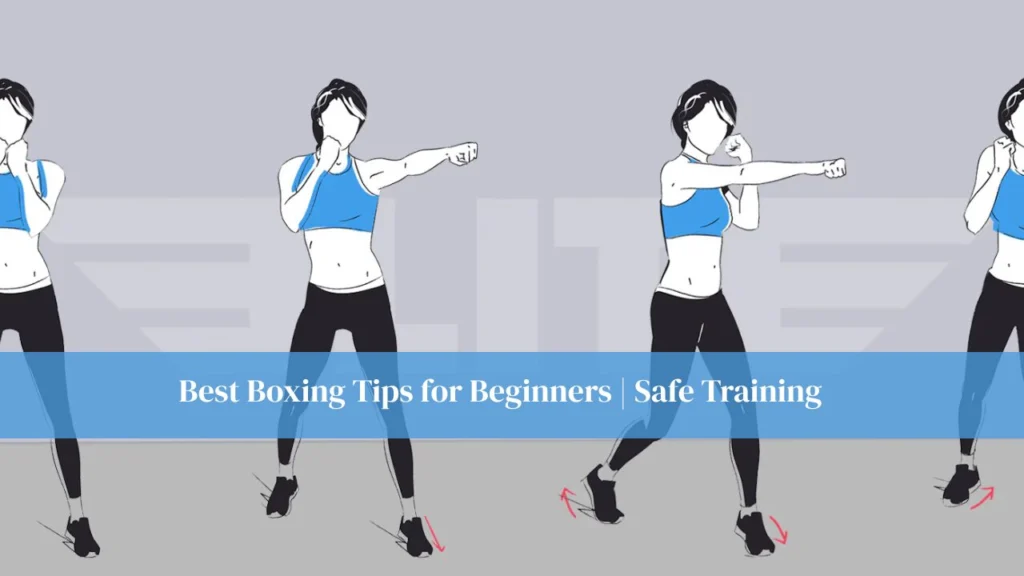Boxing is an efficient, challenging, and rewarding way to get fit, build confidence, and learn a new skill. If you’re just starting out, these boxing tips for beginners will help you train safely, build solid fundamentals, and avoid common mistakes that slow progress or cause injury. Whether you want to box for fitness, self-defense, or to compete, this guide lays out a practical, step-by-step approach from gear and stance to drills, safety, and a beginner-friendly weekly plan.
Key Takeaways
- Focus on mastering stance and footwork first to build a strong foundation and prevent injuries.
- Prioritize learning basic punches (jab, cross, hook, uppercut) with proper technique before increasing speed or power.
- Use essential gear like hand wraps, gloves, mouthguard, and proper shoes to train safely and protect yourself.
- Follow a structured 8-week training plan with gradual progression, recovery, and solo drills to improve skill and conditioning.
Top Boxing Tips for Beginners
Learning boxing the right way reduces your risk of injury and speeds up improvement. The first thing to focus on is mastering your stance. A strong and steady base makes every punch and defensive move more effective. Once you are comfortable with your stance, you should prioritize footwork because it is the foundation of both offense and defense. Good footwork allows you to create angles, move in and out efficiently, and maintain balance while throwing punches.
The next crucial step is learning the jab, which is considered the most important punch in boxing. It helps you measure distance, establish rhythm, and set up combinations. Instead of rushing into sparring, spend time shadowboxing. This will allow you to build your technique without the stress of incoming punches. Finally, work on conditioning gradually rather than trying to push intensity from the start. Consistency during your first six to eight weeks will be far more valuable than occasional bursts of high effort.
Essential Gear (what to buy first)
Every beginner needs a few essential items before starting regular training. Hand wraps are the first priority because they protect your wrists and knuckles during impact. Training gloves, usually between twelve and sixteen ounces, provide the right balance of padding and protection for bag work and mitt drills. A mouthguard is absolutely necessary once you begin sparring and should not be overlooked. Comfortable shoes are also important; although boxing or wrestling shoes are best, lightweight athletic shoes are fine for the first few weeks. Finally, a jump rope is one of the most effective and affordable training tools you can add to your kit, offering a great way to build coordination and cardiovascular endurance.
Tip: If you’re training at a gym, check with coaches about glove policies before buying.
Choosing gloves and wraps requires some thought. Wraps are designed to secure the wrist and knuckles, and a basic four-to-six inch wrap is usually enough for beginners. Spend a few minutes learning how to wrap correctly so that it becomes second nature before training. For glove weight, most beginners will find fourteen to sixteen ounce gloves useful for sparring and bag work, while lighter gloves are more common for competition but provide less padding. It is also wise to keep separate gloves for bag work and sparring, since each has different design priorities.
When it comes to mouthguards, boil-and-bite guards work well initially, but if you spar regularly, investing in a custom guard is recommended. A simple hand-wrap sequence involves looping the wrap around the thumb, covering the knuckles several times, then wrapping the wrist for stability. Ask a coach to check your wrap for proper tightness; wraps that are too tight restrict blood flow, while loose ones offer little protection.
Basic Technique The Building Blocks
Your boxing technique starts with your stance and guard. Stand with your feet shoulder-width apart, with your lead foot slightly forward. Keep a slight bend in the knees and distribute your weight on the balls of your feet so that you are always ready to move. Hands should be held high to protect the chin, with elbows tucked in to guard the body. This position may feel awkward at first, but it is essential for both attack and defense.
The four core punches are the jab, cross, hook, and uppercut. The jab is a quick, straight punch thrown with the lead hand and is used to establish distance and timing. The cross is a powerful straight punch from the rear hand that relies on hip rotation and a push off the back foot to generate force. The hook is a shorter, circular punch thrown with either hand; it requires torso rotation and proper elbow positioning. The uppercut is best used at close range, where you dip slightly and then drive your fist upward using power from your legs. Beginners should practice each punch slowly to focus on form before increasing speed. A good routine is to shadowbox three rounds of two to three minutes, dedicating each round to a single punch type.
Footwork Fundamentals
Great fighters often rely on their feet as much as their hands. Beginners should remember that boxing footwork is about small, controlled steps rather than hopping or jumping. Always step with the lead foot first when moving forward or laterally, and allow the back foot to follow in sync. This ensures balance and power transfer. Pivoting is another essential skill because it allows you to create angles, avoid punches, and set up counters.
A useful drill is to circle around an imaginary opponent for two minutes, throwing a jab every few steps and pivoting sharply after each jab. Over time, this develops smooth movement and better positioning.
Training Plan for the First 8 Weeks
A structured training plan will help you progress consistently. In the first eight weeks, aim for three to four sessions per week. The first day can focus on technique and skill: warm up, shadowbox, work on the bag with specific technical goals, and finish with a cool-down. The second day can emphasize conditioning with jump rope, intervals, and bodyweight exercises such as push-ups, squats, and core work. On the third day, work on mitts or pad drills with a coach, and if you are ready, begin supervised light sparring. The fourth day should be active recovery, which can include light shadowboxing, mobility work, or yoga. Progress gradually by starting with two to three minute rounds and adding one additional round every two to three weeks.
How to Find a Coach or Gym
Finding the right coach can greatly influence your learning curve. A qualified coach often has amateur or professional fighting experience and should also have current first aid certification. Smaller classes usually allow more individual feedback, which is important when learning the basics. Before committing, observe how the coach interacts with students. A good coach explains the reasoning behind drills, corrects mistakes clearly, and emphasizes safety. The gym’s culture also matters; a respectful and disciplined atmosphere will make your learning experience better. If a gym refuses to let you watch a class, that can be a red flag worth noting.
Mini Case Study A Beginner’s Progress in 8 Weeks
To illustrate a typical timeline, consider an anonymized example of a beginner who trains three times a week while following the training plan above. By the third week, this person usually notices better footwork control, as moving in stance becomes more natural. By the sixth week, their punches are cleaner, faster, and more consistent because of improved mechanics and rhythm. By the eighth week, conditioning improves noticeably, with more stamina during rounds and faster recovery. While progress varies depending on age, prior fitness, and training frequency, this eight-week timeline represents a common pattern seen by coaches.
Safety and Injury Prevention
Safety should be a top priority for every beginner. Warming up thoroughly for at least eight to twelve minutes with dynamic movements will prepare the muscles and joints, reducing the risk of injury. Always wrap your hands correctly and wear gloves appropriate for the type of training you are doing. When it comes to sparring, start only under a coach’s supervision, keep the intensity light, and communicate openly with your partner.
Learning to recognize signs of concussion such as dizziness, nausea, or confusion is vital. If you experience any of these symptoms, stop training immediately and seek medical help. Governing bodies emphasize on-site medical checks and conservative return-to-play protocols. Following these guidelines ensures that you can enjoy boxing safely for the long term.
Nutrition, Recovery, and Mobility
Boxing demands energy, and the right nutrition plays a central role. Before workouts, focus on whole-food carbohydrates such as oats, rice, or fruit to fuel performance. After training, lean proteins will support muscle repair and recovery. Hydration is equally important; sipping water consistently throughout the day and considering electrolytes for longer sessions helps maintain performance.
Recovery also includes adequate sleep, with seven to nine hours recommended each night. At least one full rest day per week is essential to avoid burnout. Mobility exercises for the shoulders, hips, and ankles at the end of training help keep your movements efficient and reduce the chance of injury.
Common Beginner Mistakes and How to Fix Them
Many beginners make similar errors when they first start. Throwing wild punches without control is one of the most frequent mistakes. Slowing down and focusing on accuracy will always be more effective than rushing. Another common issue is dropping the hands after throwing a punch. Train yourself to return your hands to guard immediately. Stiff hips are also a problem, as power in boxing comes from hip rotation and leg drive. Practicing mobility and rotation drills can correct this. Finally, sparring too early is a mistake many beginners regret. Developing fundamentals before engaging in heavy contact ensures long-term improvement and confidence.
Simple Drills to Practice Alone
Solo drills can accelerate your progress. Shadowboxing for three rounds of two to three minutes helps you visualize an opponent and refine your technique. On the heavy bag, practice simple three-punch combinations such as jab-cross-hook for six rounds of two minutes each. Using a double-end bag sharpens timing and accuracy, while jump rope intervals build endurance and coordination. These drills require minimal equipment but provide significant benefits for skill and conditioning.
FAQs
How often should a beginner box each week?
Beginners should aim for three to four sessions weekly, balancing technical skill days with conditioning and recovery.
When can I start sparring safely?
Supervised sparring should only begin after six to eight weeks of consistent training and with a coach’s approval.
Do I need special shoes for boxing?
You don’t need boxing shoes right away. Comfortable athletic shoes will suffice in the first few weeks. When you are committed to long-term training, invest in proper boxing or wrestling shoes.
Will boxing make me bulky?
Boxing typically builds lean strength and improves conditioning. It reduces body fat and increases muscle tone rather than creating bulk.
What if I’m nervous about getting hit?
Feeling nervous is natural. Start with non-contact drills such as shadowboxing or mitts, then gradually build confidence. Always communicate your comfort level with coaches and training partners.
Quick Checklist Before Every Session
Before each training session, make sure your hands are wrapped correctly and you are wearing the right gloves. If you are sparring, don’t forget your mouthguard. Stay hydrated throughout the day and have a small pre-workout snack about an hour before training. Above all, remember to focus on form and technique instead of power.
Conclusion
Boxing is a skill-based sport that rewards patience, consistency, and smart practice. Use these boxing tips for beginners to build the fundamentals safely. Start with stance and footwork, focus on technique before power, protect your head and hands, and follow a gradual training plan. If you’re serious, seek out a qualified coach who can guide your sparring and progression. With dedication and smart training, you’ll develop not only boxing skills but also confidence, discipline, and fitness. Visit Boxing Essential to explore more.




